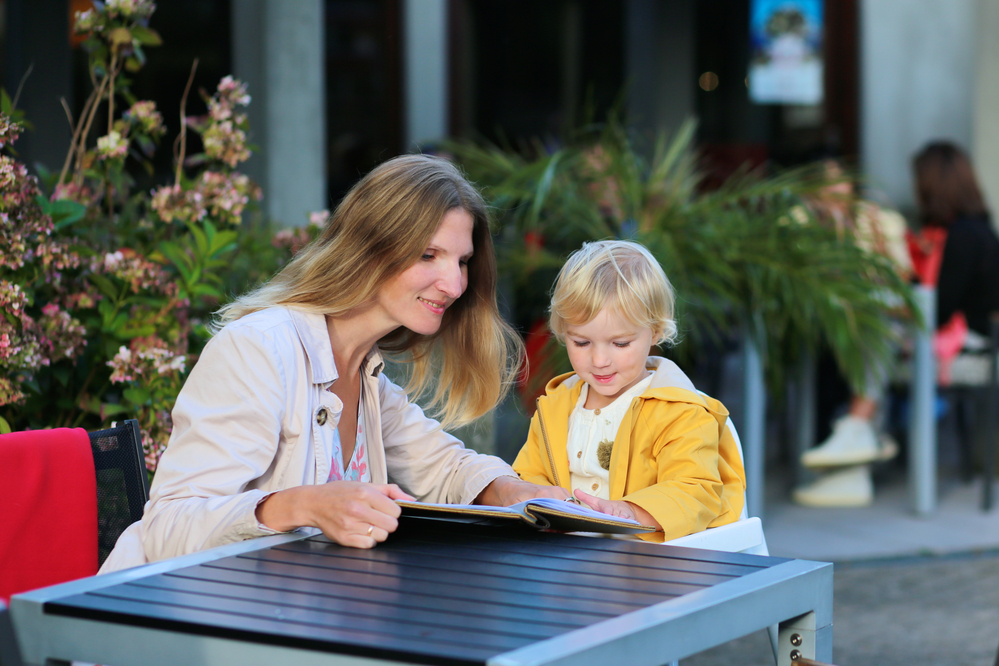Print awareness is a component of reading and writing that we rarely think much about. Instead we tend to focus on the alphabet, spelling, or phonemes. But just as these concepts are essential for early literacy, so is print awareness.
What Is Print Awareness?

Print is everywhere around us. From the books, newspapers, and magazines we read to road signs and billboards we see as we travel the streets to labels on cans in our kitchens, print is omnipresent.
Print awareness helps us interpret all this information. Without it, we’d be stuck in a world filled with lots of letters and words that are neither here nor there.
A child with print awareness notices the print around them and so much more.
They also understand the structure of print (in English, we read from left to right and from the top of the page to the bottom) and that printed words have varying functions (a book tells a story, a restaurant menu tells you what you can expect at that restaurant, road signs help guide drivers, etc.).
You can say that print awareness helps us interpret the print we come across in our everyday lives and it is an essential pre-reading concept for children to grasp.
Of course, this understanding doesn’t happen overnight. Beginning at around two years old, your child will start to become more and more familiar with the purpose of books and how books and other reading materials function.
Why Is It Important?
Print awareness helps a child understand that written words communicate just as spoken words do — that you can say the words that are written down and that every word you say can, likewise, be written. This is not something a child is born understanding.
As children are introduced to different books and stories at school and at home, they may initially think of print and spoken words as two separate entities. However, with more exposure, the concept grows and becomes more sophisticated.
This is something that’s easy to take for granted. Consider this fact: Written language as a way to express and record our thoughts is only about 5,000 years old.
Humans, therefore, existed for hundreds of thousands of years without print. In other words, reading is not something humans are born knowing how to do.
In addition to grasping the connection between printed words and spoken words, print awareness helps children understand:
- How to hold a book, turn pages, read from the front of the book to the back of the book and from left to right
- That print is a source of information and enjoyment
- That different prints have different functions — a book tells a story, a recipe gives directions for cooking, and so on.
By now, we hope you’ve realized the importance of print awareness in early childhood literacy. Without it, learning to read can become a challenge for kids of any age.
How do you know if your emerging reader has mastered print awareness? Let’s take a look.
Checking Your Child’s Print Awareness

While reading at home with your child, you can make a few observations to discover if they’ve developed print awareness. Here are some things to look for:
- They are able to show you the title of a book
- They help you turn the pages
- They point to a word and ask, “What does that say?”
- They express an interest in writing their own name
While engaging with print helps develop print awareness, that is not the only way for children to learn this skill. You can also practice print awareness throughout the day — without it feeling like a chore!
For example, you might say a sentence and ask your child how many words are in that sentence. For example, after saying, “Let’s have dinner,” ask them, “How many words was that?”
After print awareness has been established, you can also get into the habit of helping your child understand different punctuation marks. For example, when you see an exclamation mark, point to it and explain that it tells you to read in an excited voice.
4 Ways To Help Your Child Develop Print Awareness
Now that you understand what print awareness is and why it matters, here are a few tips to help your young learner develop this essential literacy skill.
1) Read Books Regularly

There isn’t enough space in this article to fully explain the importance of reading books to children. But, in a nutshell, reading to children is the single most valuable action you can take to help them become enthusiastic readers.
Reading aloud helps children develop listening and language skills. It also helps expand their understanding of the world around them and stimulates their imaginations. Plus, there’s the fact that it can help improve their reading and spelling skills.
As you can see, reading offers some incredible benefits for kids (and adults), and the younger they start the better. Try to set aside a few minutes a day to read to and with your child.
While you’re reading, you can also do certain small things to help with print awareness. For example, run your finger under a sentence as you read it, and point out the title and author of the book, and let your child turn the page.
2) Teach The Alphabet

Teaching the alphabet doesn’t have to be reserved for school. You can help your child learn the alphabet anytime!
There are plenty of ways to make learning the alphabet more exciting while learning at home. You can:
- Read alphabet books
- Sing the alphabet song
- Use playdough to create letter shapes
These are just a few ideas. The sky’s the limit! The more you familiarize your child with the alphabet, the more comfortable they will be as they start reading themselves.
3) Write For Pretend Play
While reading books helps introduce young learners to print awareness as an essential part of stories, pretend play can help expand this essential skill.
Going grocery shopping later today? Ask your child to help you write down the grocery list. Baking something new over the weekend? You’ll need a recipe for that, and who better to help you write that than your young learner?
And don’t forget to make it fun! Our Mail Adventure Printables are a great way to encourage writing as part of pretend play.
4) Read Other Types Of Print

So often, we focus on reading books for print awareness. Of course, books are essential, but you can also help your emerging reader develop print awareness while going about your everyday life if you’re intentional about it.
For example:
- If you’re at a restaurant, read the menu to your child
- If you’re waiting for your turn at the doctor’s office, let your child flip through a magazine (that’s age-appropriate, of course!)
- While driving or walking, show them that the stop sign and what it means
- Before entering a store, point out how the sign on the store tells you what you can find inside
- Before playing a game, read the instructions to show that they help you play the game correctly
Avoid making these interactions “lessons.” Rather, think of it as simply verbalizing what you would normally internalize.
For instance, “There’s a stop sign. I better stop,” “I need the can that says ‘chicken soup’,” or “Look, peanut butter is on sale today!”
Try to make the interactions natural, not forced. When you do, your child will pick up a lot of skills from observing how you handle different types of print.
Reading And Writing Begins With The Basics

Here’s the good news: Children grasp many concepts quickly. Just a few times of watching you read from left to right on a page and they’ll start doing the same. Their absorbent minds are watching and taking in all that’s happening around them!
This means that print awareness isn’t really a complicated skill to teach but, rather, one that you can help develop in your child as they experience everyday life.
Helping to establish print awareness is one of the many focal points of Homer’s Learn & Grow App. In addition, the app helps build confidence, promote problem-solving skills, and foster a lifelong love of learning.
As children get older, they’ll need to do more reading, writing, text interpretation, and so much more. Let us help you lay a firm foundation so your young learner can thrive through these stages!
,


